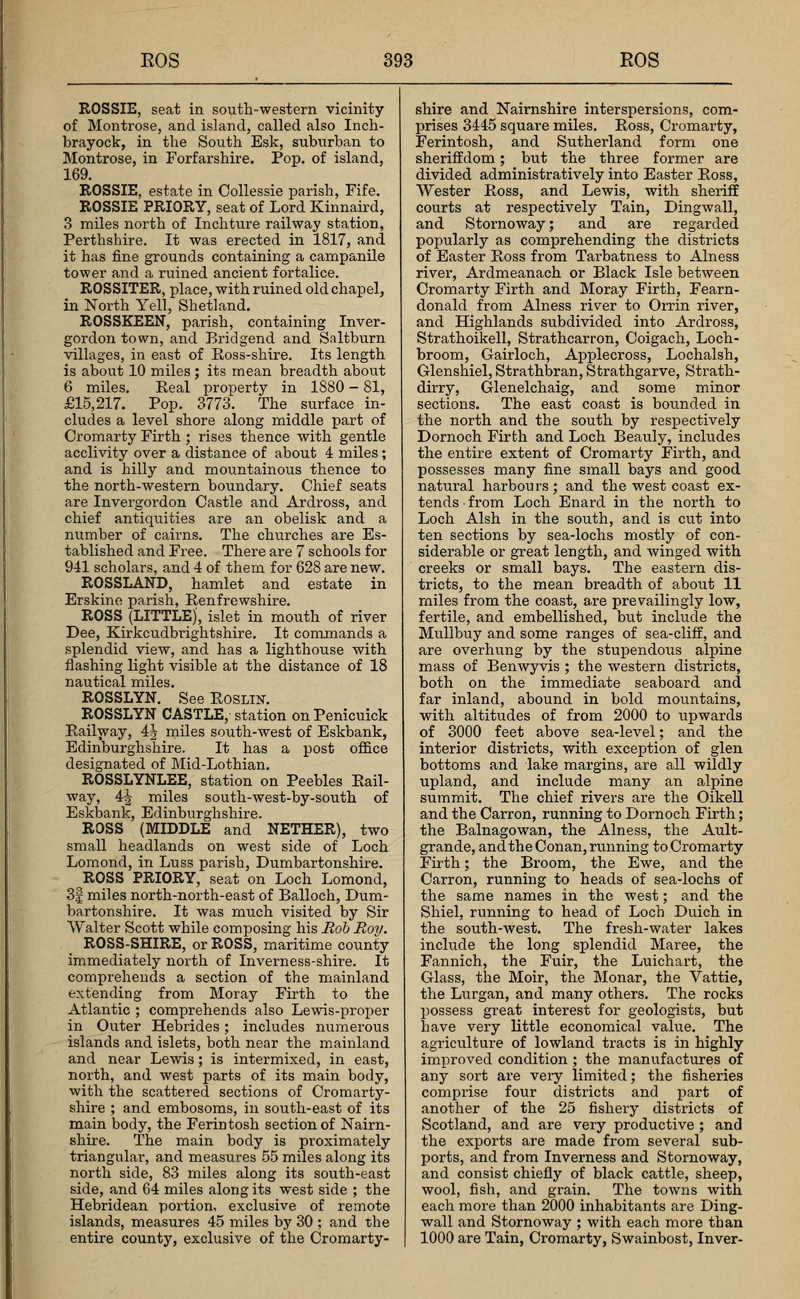ROSSIE, seat in south-western vicinity of Montrose, and island, called also Inchbrayock, in the South Esk, suburban to Montrose, in Forfarshire. Pop. of island, 169.
ROSSIE, estate in Collessie parish, Fife.
ROSSIE PRIORY, seat of Lord Kinnaird, 3 miles north of Inchture railway station, Perthshire. It was erected in 1817, and it has fine grounds containing a campanile tower and a ruined ancient fortalice.
ROSSITER, place, with ruined old chapel, in North Yell, Shetland.
ROSSKEEN, parish, containing Invergordon town, and Bridgend and Saltburn villages, in east of Ross-shire. Its length is about 10 miles ; its mean breadth about 6 miles. Real property in 1880-81, 15,217. Pop. 3773. The surface includes a level shore along middle part of Cromarty Firth ; rises thence with gentle acclivity over a distance of about 4 miles ; and is hilly and mountainous thence to the north-western boundary. Chief seats are Invergordon Castle and Ardross, and chief antiquities are an obelisk and a number of cairns. The churches are Established and Free. There are 7 schools for 941 scholars, and 4 of them for 628 are new.
ROSSLAND, hamlet and estate in Erskine parish, Renfrewshire.
ROSS (LITTLE), islet in mouth of river Dee, Kirkcudbrightshire. It commands a splendid view, and has a lighthouse with flashing light visible at the distance of 18 nautical miles.
ROSSLYN.
ROSSLYN CASTLE, station on Penicuick Railway, 4J miles south-west of Eskbank, Edinburghshire. It has a post office designated of Mid-Lothian.
ROSSLYNLEE, station on Peebles Rail-way, 4J miles south-west-by-south of Eskbank, Edinburghshire.
ROSS (MIDDLE and NETHER), two small headlands on west side of Loch Lomond, in Luss parish, Dumbartonshire.
ROSS PRIORY, seat on Loch Lomond, 3| miles north-north-east of Balloch, Dumbartonshire. It was much visited by Sir Walter Scott while composing his Eob Roy.
ROSS-SHIRE, maritime county immediately north of Inverness-shire. It comprehends a section of the mainland extending from Moray Firth to the Atlantic ; comprehends also Lewis-proper in Outer Hebrides ; includes numerous islands and islets, both near the mainland and near Lewis ; is intermixed, in east, north, and west parts of its main body, with the scattered sections of Cromartyshire ; and embosoms, in south-east of its main body, the Ferintosh section of Nairnshire. The main body is proximately triangular, and measures 55 miles along its north side, 83 miles along its south-east side, and 64 miles along its west side ; the Hebridean portion, exclusive of remote islands, measures 45 miles by 30 ; and the entire county, exclusive of the Cromartyshire and Nairnshire interspersions, com-prises 3445 square miles. Ross, Cromarty, Ferintosh, and Sutherland form one sheriffdom ; but the three former are divided administratively into Easter Ross, Wester Ross, and Lewis, with sheriff courts at respectively Tain, Dingwall, and Stornoway; and are regarded popularly as comprehending the districts of Easter Ross from Tarbatness to Alness river, Ardmeanach or Black Isle between Cromarty Firth and Moray Firth, Fearn-donald from Alness river to Orrin river, and Highlands subdivided into Ardross, Strathoikell, Strathcarron, Coigach, Lochbroom, Gairloch, Applecross, Lochalsh, Glenshiel, Strathbran, Strathgarve, Strath-dirry, Glenelchaig, and some minor sections. The east coast is bounded in the north and the south by respectively Dornoch Firth and Loch Beauly, includes the entire extent of Cromarty Firth, and possesses many fine small bays and good natural harbours; and the west coast ex-tends from Loch Enard in the north to Loch Alsh in the south, and is cut into ten sections by sea-lochs mostly of considerable or great length, and winged with creeks or small bays. The eastern districts, to the mean breadth of about 11 miles from the coast, are prevailingly low, fertile, and embellished, but include the Mullbuy and some ranges of sea-cliff, and are overhung by the stupendous alpine mass of Benwyvis ; the western districts, both on the immediate seaboard and far inland, abound in bold mountains, with altitudes of from 2000 to upwards of 3000 feet above sea-level; and the interior districts, with exception of glen bottoms and lake margins, are all wildly upland, and include many an alpine summit. The chief rivers are the Oikell and the Carron, running to Dornoch Firth ; the Balnagowan, the Alness, the Aultgrande, and the Conan, running to Cromarty Firth; the Broom, the Ewe, and the Carron, running to heads of sea-lochs of the same names in the west ; and the Shiel, running to head of Loch Duich in the south-west. The fresh-water lakes include the long splendid Maree, the Fannich, the Fuir, the Luichart, the Glass, the Moir, the Monar, the Vattie, the Lurgan, and many others. The rocks possess great interest for geologists, but have very little economical value. The agriculture of lowland tracts is in highly improved condition ; the manufactures of any sort are very limited; the fisheries comprise four districts and part of another of the 25 fishery districts of Scotland, and are very productive ; and the exports are made from several sub-ports, and from Inverness and Stornoway, and consist chiefly of black cattle, sheep, wool, fish, and grain. The towns with each more than 2000 inhabitants are Dingwall and Stornoway ; with each more than 1000 are Tain, Cromarty, Swainbost, Invergordon, and Avoch ; and the villages with each more than 300 amcmnt to 35. Ross was inhabited by the Caledonian Creones and Cantae ; was held along with Moray province by Macbeth ; formed an earldom, from an early period till that of James ill., in favour of the Macdonalds ; passed to the Mackenzies of Kintail ; gave the peerage title of baron from 1502 till 1754 to the Eosses of Halkhead; and retains numerous monuments of both the Cale-donian and the mediaeval times. Real property of Ross in 1880-81, 301,556. Pop. of Ross and Cromarty in 1871, 80,955 ; in 1881, 78,539.

